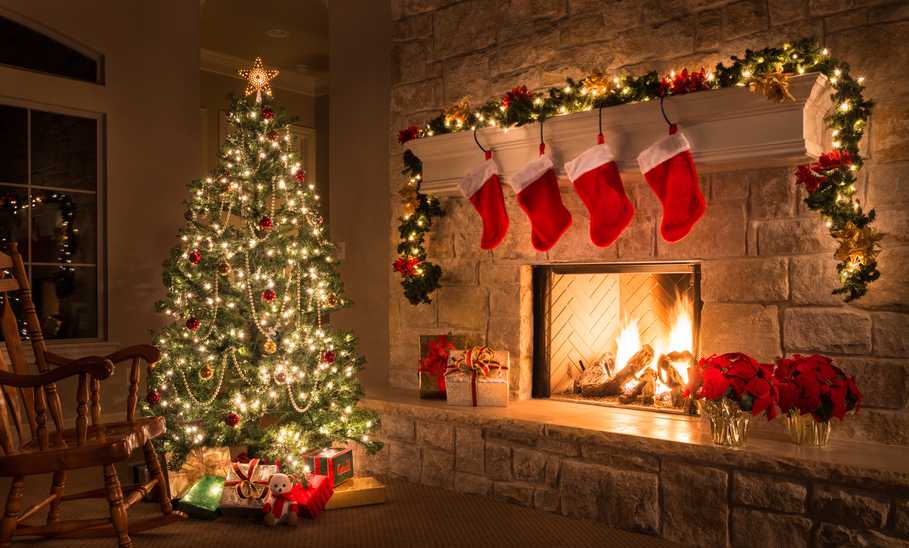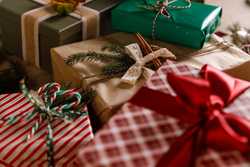How to Decorate a Christmas Tree, According to Holiday Decor Experts

Our evaluations and opinions are not influenced by our advertising relationships, but we may earn a commission from our partners’ links. This content is created by TIME Stamped, under TIME’s direction and produced in accordance with TIME’s editorial guidelines and overseen by TIME’s editorial staff. Learn more about it.
Stockings, the nativity creche, Advent calendars, nutcrackers, candles, and candy canes are all part of the decorative landscape during Christmas. In my mind, the pinnacle of holiday decor is a beautifully lit evergreen tree. With deep roots in paganism and a rich history dating as far back as the 15th century, according to the National Christmas Tree Association (NCTA), the Christmas tree remains a beloved and time-honored tradition around the world.
When I was growing up, we decorated our tree on Christmas Eve, using tinsel, string lights, and boxes of tiny toys and figurines, brass stars, silver and gold glass balls, and other ornaments, some handmade and some handed down over the generations. Now that I’m older, my kids and I put up our tree a few weeks before Christmas to enjoy it longer.
I also love looking at other Christmas trees, which you can find outdoors and indoors throughout December, in shops, restaurants, and other homes, especially the perfectly styled ones that reflect a theme or color scheme. This does not happen at my house, I have to confess. I contacted a few professional designers and holiday lovers to ask how they decorate their trees and what advice they have—here’s what they shared to help you get into the spirit this holiday season.
I love visiting our local Christmas tree farm shortly after Thanksgiving and picking out a just-cut tree because the scent lingers in our home for days, and, if we are lucky, weeks! The smell just says Christmas is here. However, I know plenty of folks who prefer an artificial Christmas tree's convenience and overall tidiness—they don’t drop needles and are easy to set up and take down each year.
“A Christmas tree should fit your needs and design style. As far as choosing real versus artificial, there isn’t one that’s better than the other. It really all comes down to preference. If you want to decorate early or you prefer to have multiple trees, artificial Christmas trees are your best bet. If you love the scent and romance of a real cut tree, then plan your decorating accordingly,” shares Emily Piepenbrink, a brand and website designer, artist, and small business owner whose personal site, Merrie, is devoted to all things Christmas. “Personally, I love a combination of both. I set up and decorate artificial trees in November and then cut a live tree for our living room after Thanksgiving.”
Martin Klarborg, director and CVO of Klarborg, which sells Danish artisan holiday and other home decor, says artificial trees have evolved over the years. “Artificial Christmas trees were considered a no-go just a decade ago, but today, there are so many realistic and beautiful options on the market that they have earned a place in our holiday homes,” says Klarborg. “Using an artificial tree allows us to extend the magical tradition of having a decorated Christmas tree in our home. In our family, we start spreading the holiday spirit early by setting up a small artificial tree in our living room in November.” Klarborg's mother is Etly Klarborg, an artist who inspired the Klarborg workshop. His family always has a real tree, too. This is one way to use both types of trees in different sizes throughout a home.
The size and shape of your tree will influence how you decorate and how it looks in the room. A too-tall tree may scrape the ceiling. If you have a real tree, you can cut from the bottom of the trunk (we’ve done this many times) to make it shorter. Ideally, you should measure the space (including a few inches to leave space between your tree topper and the ceiling) before you buy a Christmas tree.
It’s important to strike a balance between your tree and the room—an oversized tree could make a room look cozy, but it may make it impossible to move around or set up any other decorations. If your tree is too large, you may need additional lights or decorations to cover the branches. If your tree is too small, you may be unable to hang all the ornaments you love or have room under the tree for gifts.
Trees (real and artificial) come in all shapes and sizes. Although artificial trees are specifically designed for aesthetics, real trees may need branches removed to get the shape you want. There are always Charlie Brown-type trees and holiday bushes–squat trees–among the majestic ones at our Christmas tree farm. A larger room may allow for a tall and wide tree, like a Fraser Fir, and a smaller room may call for a narrow tree, like a Noble Fir, with more room between the branches. The type of tree you buy for Christmas informs its shape, too.
Some common Christmas trees are:
Lighting plays a crucial role in bringing your Christmas tree to life and setting the mood for your entire holiday decor, says Klarborg. "For both small and large trees, I recommend using warm lights to create a cozy and inviting atmosphere. Even when choosing LED lights, opt for those that emit a natural warm glow.” And always put your lights on first, before any other decorations.
“Look for lights with a color temperature between 2200K and 2700K. These warm tones provide a beautiful contrast to the blueish cold evening light that often dominates in winter, enhancing the hygge feeling in your home,” recommends Klarborg. Depending on your style, you can use colored lights or not—some people like to use multicolored string lights, while others prefer just using one or two colors. The number of lights will depend on the size of your tree.
Glass balls, small toys, charms, strings of cranberries, tinsel, and holiday treats can all be used to decorate your tree, and you can find Christmas tree ornaments made by artisans worldwide. There are so many styles out there—you’ll find a plethora to choose from at holiday markets, shops, and online. Some people, like my family, love a mishmash of old and new ornaments, while others prefer a more uniform look based on a color scheme or theme.
"If you look at Christmas trees from earlier decades, they all tended to look the same—you saw traditional glass ornaments, lots of tinsel in strand or garland form, and plenty of balls in varying sizes and colors,” says Olma Fuentes, founder and principal of Deni + Dove Interiors, a NJ-based interior design studio. “But now, Christmas trees have morphed into a major form of self-expression and are a true creative outlet. You can tell a lot about a person—their interests, where they’ve traveled to, their family composition, and even their personality—based on the ornaments they choose and how they decorate their tree.”
Fuentes, who once worked at a Neiman Marcus where she helped decorate and oversee its seasonal trim shop within holiday decor, recommends choosing a theme or color palette before decorating. “Then decide whether you want a tree that’s filled to the brim or one that’s more modest looking. This will ultimately help you decide the type of ornaments you should get and how many you’ll need.”
Pro tip: “Larger, heavier ornaments tend to droop if they’re placed too close to the edge of a branch, and can even wind up damaging other ornaments. It’s a bit more work, but I like using green floral wire to secure large ornaments closer to the root of the branch so that they stand more upright,” shares Fuentes.
A tree skirt is a nice addition to your Christmas tree. It can catch fallen needles (or ornaments), create a space to safely put gifts, and become a part of your overall decor. Make sure to measure the area you want to cover if you plan to buy a tree skirt.
For many years, my family used a tartan-patterned flat bed sheet or an old colorful blanket and simply wrapped it around the base of the tree, so if you don’t want to buy an actual skirt, there are other options (maybe even in your linen closet).
While a tree skirt is optional, a tree without a topper may look bare. Traditional toppers include an angel or star, but many ways to top your tree exist. “A tree topper is always a fun way to finish your tree. An angel or star works well if you’re going for a more traditional look, but other varieties, such as a snowflake or even a Santa Claus, are equally festive and will also help complete the look of your tree,” suggests Fuentes.
Other ways to enhance a Christmas tree are candy canes, chocolate ornaments wrapped in colorful foil with gold string, and Victorian tinsel. My family usually buys or makes a few edible ornaments each year, which we enjoy the day the tree comes down, and around here, Santa has been known to hide or tie small, brightly wrapped gifts onto branches of the tree. The small wrapped packages act as decor as well in our home. Just wrap them in paper that matches the overall aesthetic of your tree.
Ribbon is another decorating essential because of its versatility. “You can use ribbon to make smaller bows as ornaments, as a garland to wrap around your tree, and it even looks great as a large tree topper,” shares Fuentes.
Christmas's red and green colors, like those of the Christmas tree, have roots in paganism and ancient worship. Holly and other evergreens were used in winter festivals, like Solstice, and the continuation of these colors was later adopted into the Christmas holidays. This pairing continues to be part of the Christmas tapestry of colors and looks good with gold embellishments, plaid ribbons and decor, warm whites, and wood and natural accents, like pinecones.
Just like the Christmas song “Silver and Gold” from Rudolph the Red-Nosed Reindeer by Burl Ives, these two colors will add a glorious shine to your season. You can mix silver and gold glass balls, ornaments, and other items in these two colors to create a more modern look. Consider silver and gold ribbons and gold and silver florals, and I also love these star garlands. These colors look particularly beautiful on a Blue Spruce because of its slightly bluish-green needles.
One of my favorite holiday tree designs is a winter wonderland theme, which is easy to achieve with wooden and homemade ornaments, elements of nature such as pine cones, clove-studded oranges, warm lights, and even faux snow. Bottlebrush animals of the forest (dressed for Christmas, naturally) and silver stars are also good additions.
Bringing the art of hygge into your home at Christmas can include how you decorate your tree and its surroundings. Klarborg suggests the following, in his words, as a guide to creating a minimalist and Scandinavian-style Christmas tree.
Ombre (one color, many shades) or a gradient decor (shows a gradual change in color, like from pink to blue to green, etc are two styles that are a modern way to decorate your tree for Christmas. Pick a one-color holiday scheme and create an ombre pattern starting with one shade at the bottom and working your way up to the top of the tree (or in reverse, if you prefer); the same for using gradient decorations on your tree.
Once you figure out a set of colors using an ombre or gradient pattern, section the tree (like six sections—two for each major part of the tree: bottom, middle, and top, for example) and decorate each section with a different color to create a rainbow-style hue on your tree.
It’s easy these days to decorate your tree with sustainable decorations; you can purchase artisan and eco-friendly decorations, but making them is also easy. For example, pine cones and other greenery, like holly eucalyptus sprigs, are used among the branches. Then, add dried citrus and spices by hanging dried orange slices or cinnamon sticks for a natural scent and look, suggests Klarborg.
If this is the style you’re going for, it’s a great way to spend time DIY-ing ornaments with your friends and family–popcorn strings with fresh cranberries, dried oranges stuck with star anise or cloves, and tiny origami stars and animals made from scraps of paper you have at home.
Whether you have a real or artificial tree, you can fluff it out to make it appear fuller. First, get work gloves because pine needles can be sharp. Start at the bottom of the tree and work with the innermost branches first and then the outer branches. Separate each branch and fan them out by angling them upward to give them more room (i.e., space between the branches) for hanging ornaments or hiding small packages.
In addition, making space between the branches gives you the appearance of a fuller tree. Some experts recommend making a pattern; one branch should turn upwards, and the next downwards. Work your way up to the top! Note: I have never done this, but I have spent time fluffing Christmas trees so the branches are not too tightly packed.
Hint: If you place the tree on its stand overnight after you get it home, (we leave ours outside), the branches will naturally go down a bit on their own. It can take a long time to fluff a large tree (make sure to have a safe step ladder available), so you’ll need patience and maybe a glass of spirits or hot chocolate.
Start at the base and work up to the top of the tree, settling the lights within the tree rather than draping them over it. Make sure to distribute them evenly throughout. If you use large and small lights, layer them. “By installing lights first, you can place some closer to the trunk and others towards the branch tips, adding depth and a luminous backdrop for your ornaments,” says Klarborg.
“Ribbons, classic ornaments in a solid color, and floral picks are tried and true tree-trimming essentials. If you’re buying all of these for the first time or for a new tree, stick with one color palette. That will make decorating easy and allow you to reuse them again and again,” suggests Piepenbrink.
If you plan to add ribbons and garlands, Fuentes says you should put them on the tree after the lights. “Be sure to add your ornaments after you’ve hung up your garland. That way, the garland won’t cover anything up, and you’ll be able to visualize the best placement for each ornament better,” she says.
After you’ve fluffed the tree, hung the lights, and added garlands, it’s time to put on the ornaments. While it can be tempting to hang them in no specific order, think about placement—if you have heavy ornaments, move them toward the back of the branch for better support; lighter ornaments can go toward the front.
Make sure they hang on the branch rather than sit on it, and put at least an inch between them. If you have more than one kind of the same ornament, space them out so they’re not hanging next to each other. Also, if you have young children, put any breakable or fragile ones high up so little hands can’t grab them. It’s best to decorate top to bottom for an even spread of ornaments.
Pro tip: “Buy decorations in different sizes. One of the biggest rookie mistakes is trying to fill an 8-foot tree with 3-inch ornaments. Ornaments in different sizes give your Christmas tree interest and drama,” says Piepenbrink. “Invest in zip ties or floral wire. Don’t hang your ornaments with the ties they come with or cheap metal hooks. Use zip ties or wire to secure your decor exactly how you want it on your tree.”
Last, set up your step ladder and attach a topper to the tree. Some toppers have their own lights, and others don’t. Make sure the topper is securely fastened so it doesn’t fall off.
You can’t go wrong with any combination of red, green, and snowy white. A metallic color palette will also be in style, no matter the other trends, shares Piepenbrink. “If you’re looking to design a more modern Christmas tree, think about using ornaments and decor in more distinct shapes, like starbursts or bold rectangles, or in non-traditional palettes, like neon or black. For lovers of minimalism, design a more simplified tree. Choose one color and/or one decor item only. For instance, tying ribbon bows in one color with only white lights makes for a beautiful, minimalist Christmas tree.”
Space out your ornaments so your tree doesn’t feel overcrowded, and keep a mix of items on hand to fill in gaps for a tree that may not have enough ornaments. “Christmas glass balls are a perennial decorating staple, but I recommend keeping some larger ones on hand to fill in any noticeable gaps and to help make your tree appear fuller,” recommends Fuentes.
Before you begin, make sure to have an idea in mind for the final look. “Start with the final design for your Christmas tree and work backward. So I always imagine where the tree will be and how I want it to feel. Then, once I’ve got it pictured, I can make a list of what I need,” says Piepenbrink. “To source all of the Christmas tree decorations, I make a mood board on Pinterest and then start hunting. When you’re purchasing Christmas tree decorations, buy more than what you think! There are tons of guides online to give you a rough idea but believe me. It’s always more than what you think.”
Fuentes adds, “Don’t forget to add a few items that will make your tree feel more unique and special. Perhaps some handmade decorations, a special ornament that honors an important event or person, or some other Christmas trimmings that reflect your personality or interests. Everyone wants their tree to look beautiful, but a tree that looks too perfect lacks warmth and winds up feeling impersonal.”
First, make sure to have a large enough Christmas tree stand to support your tree, according to the National Christmas Tree Association. It needs room to support the tree and allow it to drink water. A tree can use “up to one quart of water per day for each inch of stem diameter. Therefore, a stand that will hold a 4-inch trunk should hold at least one gallon (4 quarts) of water with the tree in the stand,” states the NCTA website.
Most trees will drop some needles over time, but you want to keep it away from heat sources like radiators and keep it hydrated. A tree skirt can catch needles so they don’t end up all over the room.
First, remove all the lights, garlands, and ornaments. Next, clean all its branches and the top and trunk with a damp cloth (or a vacuum cleaner with a duster apparatus on a low setting). If it comes apart (and most have at least two main pieces), carefully disassemble it. Invest in a quality tree bag to store your tree during the year, then place it in a cool, dry area of your home.
The information presented here is created by TIME Stamped and overseen by TIME editorial staff. To learn more, see our About Us page.



